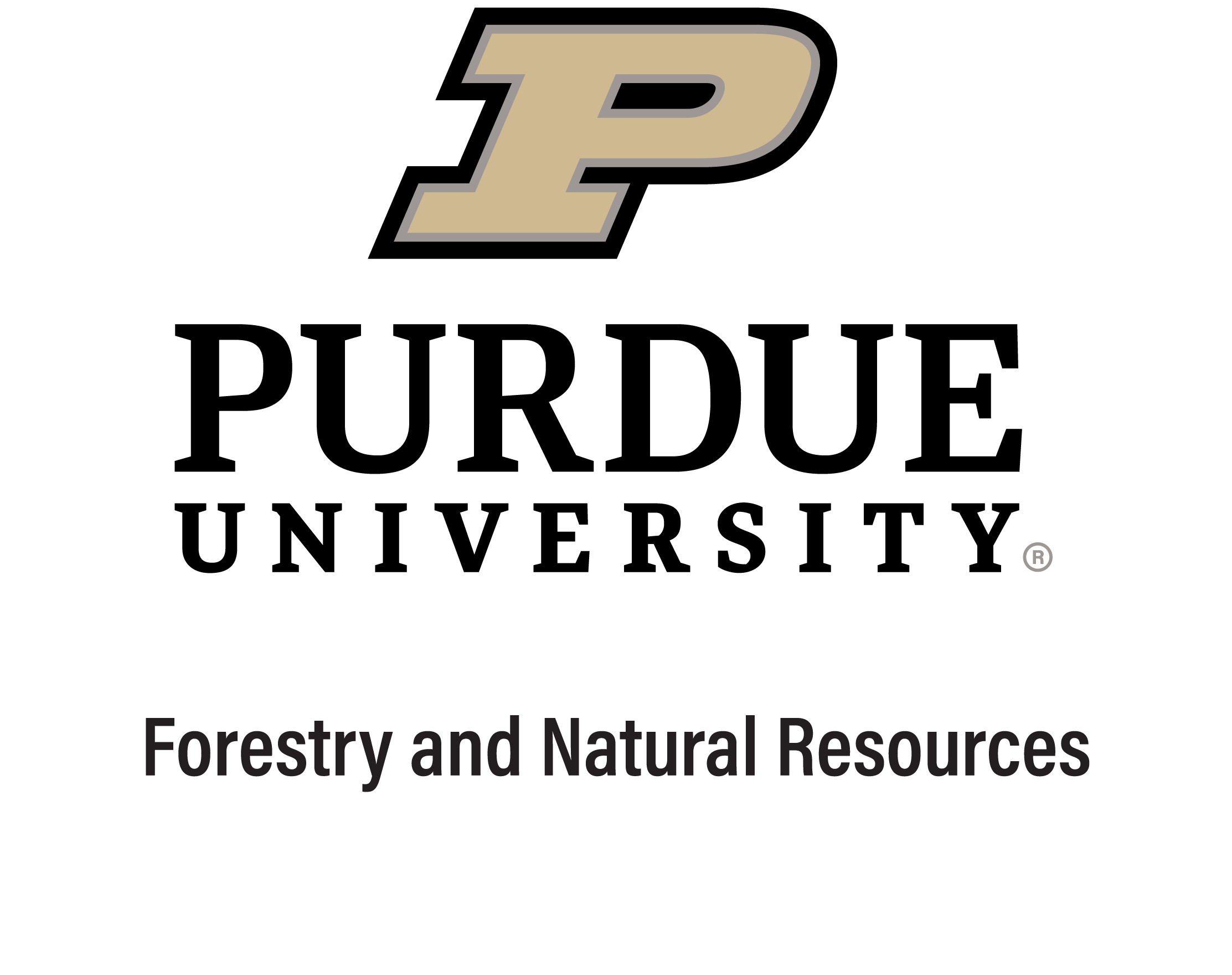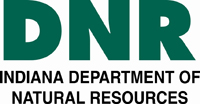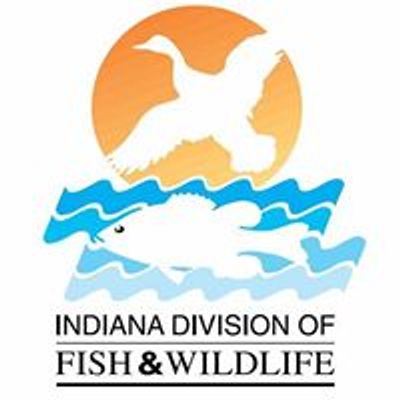Project Partners by State
Georgia
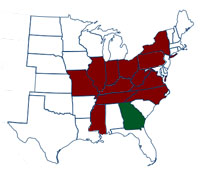
Illinois
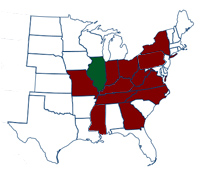
Endangered Species Protection Board: dnr.espb@illinois.gov
More information regarding Hellbenders in Illinois can be found at the Illinois Natural History (INHS) Herpetology Collection - Hellbender.
Indiana
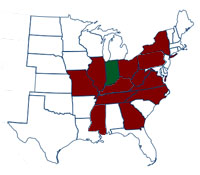
195 Marsteller Street, West Lafayette, IN 47907-2033
Nick Burgmeier
Phone: 765-494-3568
Nate Engbrecht
5596 E. State Rd. 46, Bloomington, IN 47401
(812) 334-1137
 Hellbenders are only found in the Blue River watershed region of Indiana. Historically they had a much larger range, but the population dropped drastically due to pollution and other factors. There are only a few hundred hellbenders left in the state, so conservation is very important. Several organizations, such as Purdue university and the Indiana Department of Natural Resources, are working on research and conservation of hellbenders as well as outreach to the public. Purdue has a captive rearing program for hellbenders and also performs research on hellbenders and how to improve conservation efforts. Several zoos in the state are working with Purdue in order to establish more captive rearing programs for hellbenders.
Hellbenders are only found in the Blue River watershed region of Indiana. Historically they had a much larger range, but the population dropped drastically due to pollution and other factors. There are only a few hundred hellbenders left in the state, so conservation is very important. Several organizations, such as Purdue university and the Indiana Department of Natural Resources, are working on research and conservation of hellbenders as well as outreach to the public. Purdue has a captive rearing program for hellbenders and also performs research on hellbenders and how to improve conservation efforts. Several zoos in the state are working with Purdue in order to establish more captive rearing programs for hellbenders.
Purdue University also is heavily involved in hellbender extension and outreach, including this website, educational videos, and other literature.also participates in these education and outreach programs. Events, such as "Help the Hellbender Day", in which the Columbian park zoo hosted games and private tours of their hellbender facilities, and Purdue university brought informational booth and activities. Purdue also attends local community programs like the Master Gardener Fair, in which Purdue set up an informational booth and provided flyers and brochures about hellbender conservation and water quality. and community nature programs are held often in order to educate the public about hellbender conservation. The Purdue Student Chapter of Environmental Education (SCEE) is also heavily involved in hellbender outreach. SCEE participates in community nature programs and school visits in order to encourage healthy water habits.
Meet Herbie
Herbie is the mascot of the hellbender conservation movement in Indiana, although he's much bigger and much softer than a typical hellbender. Herbie can be seen at Purdue events like Help the Hellbender Day greeting all of the visitors. He loves spreading the word about hellbenders, meeting new people, and eating lots of crayfish. If you see him out and about, be sure to say hi! You can also get a picture with Herbie and post it to instagram or facebook with the hashtag #herbie or #helpthehellbender.
Research
The Help the Hellbender team collaborates with many partners in the conservation efforts for the hellbender. The list of Purdue Hellbender research publications continues to be shared with scientists and conservation enthusiasts around the world.
Former Students
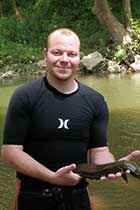
Bart Kraus is a masters student with research focused on the spatial ecology and survivorship of translocated and resident eastern hellbenders (Cryptobranchus alleganiensis alleganiensis) in the Blue River, IN. Recent population declines throughout their range have prompted concern about the persistence of this species. Indiana’s eastern hellbender population has been restricted to the Blue River, located within one of the southernmost watersheds in the state. Previous telemetry research suggests individuals are scattered throughout the river and/or are spatially isolated from one another. He hopes to increase local hellbender population densities using translocations. He will then determine their home range, both temporally and spatially, and dispersal distances (of translocated individuals) in order to help determine the feasibility of hellbender translocations. Additionally, he would like to estimate the survivorship of both translocated and resident hellbender to determine translocation success and to inform state management agencies when deciding on the future conservation efforts for this species.

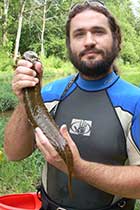
Kentucky

Wildlife Diversity Program
1 Sportsman's Lane, Frankfort, KY 40601
(800) 858-1549
Mississippi
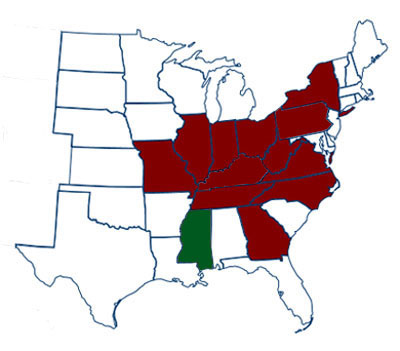
2148 Riverside Drive, MS 39202
Phone: 601-576-6000
Sheena Feist, Conservation Resources Biologist, Mississippi Natural Heritage Program
Email: Sheena.Feist@mmns.state.ms.us
Email: Tom.Mann@mmns.state.ms.us
Missouri
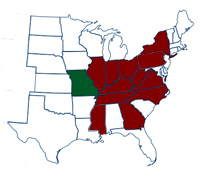
Conservation Headquarters
2901 W. Truman Blvd., Jefferson City, MO 65109
Phone: 573-751-4115
Fax: 573-751-4467
New York
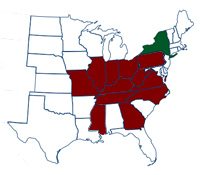
New York State Department of Environmental Conservation (NYSDEC)
625 Broadway, Albany, NY 12233-4754
518-402-8924
Michelle R. Herman, M.Sc., Biological Technician The Wetland Trust
118 Golf Course Road
Mobile: 814-232-1204
Email: mh@thewetlandtrust.org
North Carolina
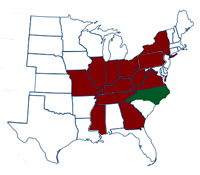
Mailing Address: 1701 Mail Service Center
Raleigh, NC 27699-1701
Phone: 919-707-0010
John D. Groves, Curator Emeritus of Amphibians and Reptiles, North Carolina Zoo
Email: johngroves2005@yahoo.com
Email: Lori.Williams@ncwildlife.org

April 23, 2022: Spring Fling Festival, Andrews, NC (appearance by Rocky)
July 15, 2022: Private outreach with NC teachers, Pisgah National Forest, NC (appearance by Rocky)
Ohio

Phone: (614) 265-6565
Gregory Lipps, LLC
In order to maintain viable populations of the hellbender in Ohio, four recommendations are made:
- Support conservation efforts in areas where viable populations currently exist;
- Increase the use of existing conservation programs to protect hellbender habitat;
- Investigate the feasibility of a repatriation/augmentation program for hellbenders in Ohio; and,
- Continue to conduct mark-recapture surveys to monitor populations, collect demographic and growth data, and provide on-the-ground outreach and early detection of potential threats.
The Ohio Hellbender Partnership consists of representatives of the Ohio Division of Wildlife, the US Fish and Wildlife Service, several Ohio Zoos (Columbus Zoo, the Wilds, Toledo Zoo, Akron Zoo), the Ohio EPA, local soil and water conservation districts, and college/university researchers and students. We have been meeting regularly since the completion of statewide surveys to discuss strategies for reversing the decline of the hellbender in Ohio.
Pennsylvania

Trinity College
Environmental Science Program and Department of Biology
300 Summit Street, Hartford, CT 06106
Hellbender Contact:
Peter J. Petokas, Ph.D., Research Associate
Clean Water Institute and Department of Biology
Lycoming College
One College Place
Williamsport, PA 17701
Office: 570-321-4006
Mobile: 570-606-6017
Email: petokas@lycoming.edu
Tennessee
TN Wildlife Resources AgencyEllington Agricultural Center
440 Hogan Rd., Nashville, TN 37220
Phone: (615) 781-6500
Michael Freake, Professor of Biology, Lee University
Phone: 423-614-8282
Email: mfreake@leeuniveristy.edu
Virginia

William Hopkins, Ph.D. Professor and Director
Dept. of Fish and Wildlife Conservation
Conservation Physiology & Wildlife Exotoxicology
The Global Change Center at Virginia Tech
Office: 540-231-7292
Email: hopkinsw@vt.edu
In Virginia, hellbenders are found in the main-stem and tributaries of the New River drainage and in the Clinch, Powell, and Holston River tributaries of the Upper Tennessee River. In Virginia, hellbenders have been observed in streams as small as 5 meters and rivers over 100 meters wide. Because of their preference for clean streams and rivers, hellbenders serve as indicators of stream health. The presence of young and adults is synonymous with good water quality.
The eastern hellbender is a Federal Species of Concern. In Virginia, it is listed as a species of special concern and as a Tier II species in the Virginia Wildlife Action Plan.
Hellbenders cannot be sold, killed, or kept for personal use.
Several efforts are underway in Virginia to conserve and manage hellbender populations. The Virginia Department of Game and Inland Fisheries has produced an educational poster and a website to better inform the public about the plight of this species. In selected rivers in southwest Virginia, the Department is contracting researchers from Virginia Tech to assess hellbender populations in a variety of landscapes such as forested and agricultural. Techniques are being refined to cultivate hellbenders in captivity at the Department's Aquatic Wildlife Conservation Center near Marion, Virginia. Eggs that are abandoned or dislodged from nests are collected from nearby rivers and held in aquaria to determine their potential to hatch. To date, we have been able to hatch 60 hellbenders. Twenty juveniles have been released back to their natal streams. In the future, laboratory cultivation may be an effective tool to augment and re-establish the species back into their former range.
More information regarding Hellbenders in Virginia can be found at the Virginia Department of Game and Inland Fisheries site.
All information was provided by Virginia Department of Game and Inland Fisheries.
West Virginia
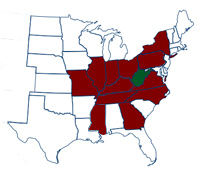
324 Fourth Ave, South Charleston, WV 25303
Phone: (304) 558-2771
Connect With Us
Facebook HelpTheHellbender, Twitter @helpthehllbend, Instagram @helpthehellbender and subscribe to our Help the Hellbender YouTube Playlist https://purdue.ag/3vA6b3O.
Help the Hellbender Twitter
